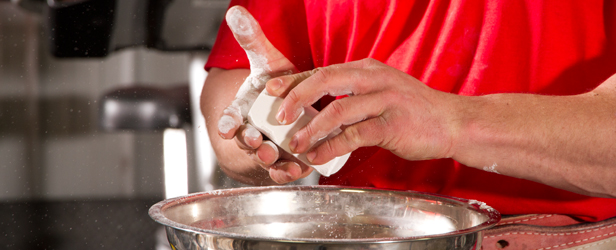
Let’s face it, whether you are a coach at a school or a trainer with your own gym, training a large group of young athletes is not an easy task. Although I completely understand that it is difficult to individualize training in groups of 15 or more, I feel that a lot of programs are just lacking common sense when it comes to exercise selection and program design. Below are five simple strategies that can help any coach maximize time in the weight room, improve performance, and reduce the risk of injury.
1. If you can’t touch your toes, then you can’t pull from the floor
A proper hip hinging pattern is needed for an athlete to touch his toes. If he can’t, then there is no way that he will be able to deadlift or Olympic lift with a straight bar from the floor. The result of putting a kid who can’t touch his toes into that position is a compensation movement, usually with the lower back. In the last 10 years, I have had numerous athletes develop mild to serious disk injuries due to this exact circumstance. So, it's not deadlifts that are bad—it is that deadlifts are bad for some kids. For more specific information on this topic, research Grey Cook.
2. Your upper body pulling volume should at least be equal to your pushing volume
Think about how many kids have internally rotated shoulders and sit in desks with rounded upper backs all day. Yet, it seems like most programs include tons of bench, incline bench, and push ups...but very little horizontal rowing. Although I understand that many schools do not have access to cable columns, DB rows, barbell rows, or inverted rows could certainly be included in every workout in addition to pull ups. Take a look at your workout and count the number of reps you do in a week on presses. Then, compare that to the number of reps you do on pulls. If your pressing number is higher, then it is time to increase your pulling volume.

3. Condition after lifting
Think of an athlete’s ability to do work like a gas tank. If you want to increase strength and power, then you must have a lot of gas in your tank in order to put full effort into every lift. Running suicides, 400s, or even the dreaded mile prior to lifting dramatically decreases the amount of gas in one's tank. The result, therefore, is a lessened ability to put max effort into the lifts (that will, in turn, make you stronger). I do understand that large teams have to go with the “half run, half lift, then flip-flop method,” but paying a little more attention to duration and intensity will help you get greater results in the weight room.
4. Let strength-to-bodyweight ratio dictate jump training
Strength-to-bodyweight ratio can easily be assessed by looking at squat numbers, the ability to do multiple chin-ups, or even just by using an eye test. If you are 200 pounds and can only squat 150 pounds, then your strength-to-bodyweight ratio is poor. The same goes for the tall, skinny basketball player who is struggling to squat without his or her knees caving in. Asking this kid to do tuck jumps, split squat jumps, or depth jumps is a disaster waiting to happen. A kid with a poor strength-to-bodyweight ratio just isn’t strong enough to absorb the force of his/her own bodyweight as it comes in contact with the ground. Box jumps, KB swing, and MB throws are excellent alternatives to jump training. Combine that with proper diet and getting stronger, and you can eventually progress.
*On a side note—I never have my big football lineman do true plyometrics, regardless of how strong they are.

5. Warm up
It absolutely blows my mind that most kids are still not warming up properly before practices or training. Dedicating the first 10 or 15 minutes of each session to improving flexibility and mobility will go a long way in improving your athletes' quality of movement. Aside from that, it gives the kids time to elevate their heart rates, get a sweat going, and get mentally prepared for the workout. Remember, they have been sitting in desks, most likely bored out their minds, for the last six hours. To me, going from that to performing hang cleans is insanity.








